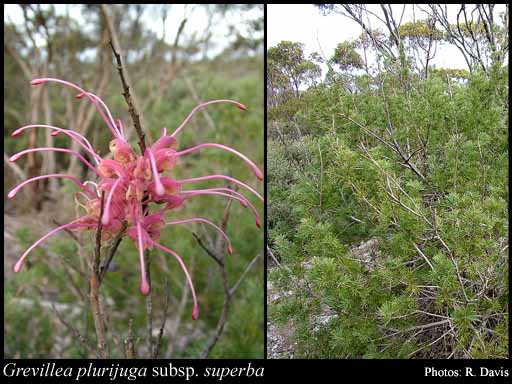- Reference
- Fl.Australia 17A:496 (2000)
- Conservation Code
- Not threatened
- Naturalised Status
- Native to Western Australia
- Name Status
- Current
Dense, robust shrub, 2-4 m high. Fl. grey-pink-red, May or Jul or Sep to Dec or Jan. Calcareous loam, grey-brown clayey sand, laterite. Gently undulating rises, above lakes.

Scientific Description
Shrubs, 0.5-2 m high; branchlets hairy, not glaucous. Leaves alternate, 20-70 mm long, glabrous; lamina flat, once divided, pinnately divided, divided to the midrib; lobes 5-20 mm long, 1-2 mm wide, the margins revolute, enclosing the lower surface of the leaf blade, forming a groove either side of the midvein. Inflorescences terminal, green, red, pink or grey; pedicels 7-10 mm long. Perianth 12-15 mm long; tepals some joined and some free after flower opens, hairy, glandular-hairy or simple-hairy; ovary glabrous, stipitate, the stipe 1.5-2 mm long; pistil 42-47 mm long, red or pink, pollen presenter lateral, style glabrous. Follicles glabrous, not viscid, dehiscent, 12-16 mm long. Flowers in October, November or December. Occurs in the Eremaean (ER) or South-west (SW) Botanical Province(s), in the Coolgardie (COO), Mallee (MAL) or Esperance Plains (ESP) IBRA subregion(s). : Conservation code Priority Two (P2).
Distribution
- IBRA Regions
- Coolgardie, Esperance Plains, Mallee.
- IBRA Subregions
- Eastern Goldfield, Eastern Mallee, Recherche.
- Local Government Areas (LGAs)
- Dundas, Esperance.